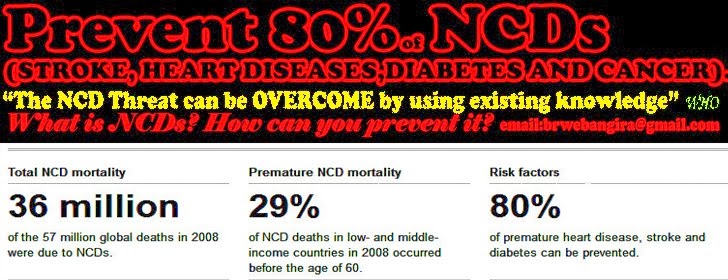Kwa mujibu wa ripoti za Shirika la Afya Duniani vifo
vitokanavyo na magonjwa yasiyo ya kuambukiza, kitaalumu Noncommunicable
Diseases (NCDs) vinatarajiwa kuongezeka maradufu ifikapo mwaka 2030.
“In African nation’s deaths from, NCDs are projected to exceed the combined deaths of communicable and nutritional diseases and maternal and prenatal deaths as the most common causes of death by 2030.”
Kwa sasa takwimu za shirika hilo zinaonesha kuwa magonjwa
haya ndio yanayoongoza duniani kuwa vifo ambapo asilimia 65 ya vifo vyotemilioni
57 kwa mwaka vinatokana na magonjwa haya ambapo asilimia 80 au milioni 29
vinatokea katika nchi za dunia ya tatu.
Hili ni janga linguine, Africa imekuwa ikipatikana na
majanga mengi sana, ikiwemo magonjwa, umasikini uliokithiri, vita, njaa,
mafuriko, n.k, yapo ambayo twaweza kusema ni mapenzi ya Mungu maana hatuna jinsi ya kuweza kuyazuia, lakini hili
linalotujia sasa si mapenzi ya Mungu, ni lakujitakia, kwani, tukiamua, tunaweza
kuepukana nalo.
Magonjwa haya kwa mujibu wa WHO yanaweza kuepukika, kwani ni
magonjwa ya mfumo ama Lifestyle Dieases, njia mbalimbali zinapendekezwa na
wataalamu, ikiwepo kupata maarifa mbalimbali, kubadili mitindo ya maisha, kubadili
namna ya ulaji wetu wa chakula pamoja na kutumia vitu asilia kwa wingi.
WHO wanasema “The NCD threat can be overcome using
existing knowledge.” Kwa maana nyingine ni kwamba yapo maarifa na
ufahamu ambao tukiupata twaweza kujiepusha na vifo hivi.
Jisomee mwenyewe HAPA
NONCOMMUNICABLE DISEASES.Noncommunicable diseases (NCDs), such as heart disease, stroke, cancer, chronic respiratory diseases and diabetes, are the leading cause of mortality in the world.This invisible epidemic is an under-appreciated cause of poverty and hinders the economic development of many countries. The burden is growing - the number of people, families and communities afflicted is increasing.Common, modifiable risk factors underlie the major NCDs. They include tobacco, harmful use of alcohol, unhealthy diet, insufficient physical activity, overweight/obesity, raised blood pressure, raised blood sugar and raised cholesterol.The NCD threat can be overcome using existing knowledge. The solutions are highly cost-effective. Comprehensive and integrated action at country level, led by governments, is the means to achieve success.Key factsv Noncommunicable diseases (NCDs) kill more than 36 million people each year.v Nearly 80% of NCD deaths - 29 million - occur in low- and middle-income countries.v More than nine million of all deaths attributed to NCDs occur before the age of 60; 90% of these "premature" deaths occurred in low- and middle-income countries.v Cardiovascular diseases account for most NCD deaths, or 17.3 million people annually, followed by cancers (7.6 million), respiratory diseases (4.2 million), and diabetes (1.3 million1).v These four groups of diseases account for around 80% of all NCD deaths.v They share four risk factors: tobacco use, physical inactivity, the harmful use of alcohol and unhealthy diets.OverviewNoncommunicable diseases (NCDs), also known as chronic diseases, are not passed from person to person. They are of long duration and generally slow progression.The four main types of noncommunicable diseases are cardiovascular diseases (like heart attacks and stroke), cancers, chronic respiratory diseases (such as chronic obstructed pulmonary disease and asthma) and diabetes.NCDs already disproportionately affect low- and middle-income countries where nearly 80% of NCD deaths – 29 million – occur. They are the leading causes of death in all regions except Africa, but current projections indicate that by 2020 the largest increases in NCD deaths will occur in Africa.In African nation’s deaths from, NCDs are projected to exceed the combined deaths of communicable and nutritional diseases and maternal and prenatal deaths as the most common causes of death by 2030.Who is at risk of such diseases?All age groups and all regions are affected by NCDs. NCDs are often associated with older age groups, but evidence shows that more than 9 million of all deaths attributed to noncommunicable diseases (NCDs) occur before the age of 60. Of these "premature" deaths, 90% occurred in low- and middle-income countries.Children, adults and the elderly are all vulnerable to the risk factors that contribute to noncommunicable diseases, whether from unhealthy diets, physical inactivity, exposure to tobacco smoke or the effects of the harmful use of alcohol.These diseases are driven by forces that include ageing, rapid unplanned urbanization, and the globalization of unhealthy lifestyles. For example, globalization of unhealthy lifestyles like unhealthy diets may show up in individuals as raised blood pressure, increased blood glucose, elevated blood lipids, overweight and obesity. These are called 'intermediate risk factors' which can lead to cardiovascular disease, a NCD.
Kwa maoni na ushauri, nitwangie 0784475576.











